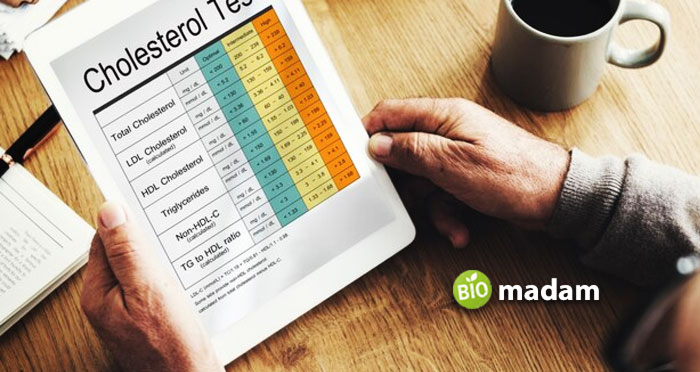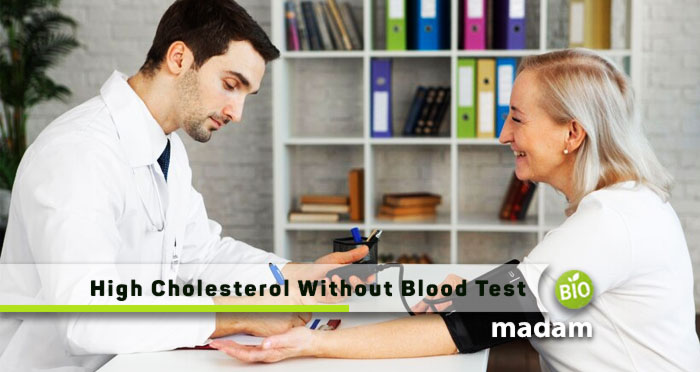Cholesterol is a must-mention when talking of fatty foods, especially in old age. You might hear people say, “Watch your cholesterol!” or “Your cholesterol will spike after that juicy buttery steak.” Even medical professionals suggest routine screening to make sure your cholesterol levels are under control. However, many people do not prefer blood tests and ask “How to tell if you have high cholesterol without a blood test?”
This article tells you how can you tell if you have high cholesterol, how to lower cholesterol without medication, and more.
But before we dive into how to look up your cholesterol without a blood test, what is it?
What is Cholesterol?
Cholesterol is a waxy substance produced by your liver, vital for various bodily components. It helps manufacture cell membranes, vitamin D, and certain hormones. Moreover, cholesterol also protects nerves.
Besides the production of cholesterol by the liver, you can also obtain it from food sources like meat, eggs, and dairy. While cholesterol is critical to body functions, high cholesterol can be harmful.
Which Cholesterol is Bad for Health?
Your body transports cholesterol by attaching it to proteins, forming lipoproteins. Cholesterol is typically categorized into two types depending on the lipoprotein formed:
HDL or Good Cholesterol
High-density lipoproteins (HDLs) carry cholesterol to the liver to help keep the cholesterol levels balanced. Your body must have enough HDLs to remove excess cholesterol from the blood. A low HDL level means you do not have enough high-density lipoproteins to eliminate extra cholesterol from the blood.

LDL or Bad Cholesterol
Low-density lipoproteins (LDLs) are also called bad cholesterol as they lead to cholesterol accumulation in the arteries when transporting cholesterol throughout the body.
What is High Cholesterol?
High levels of LDL in the body are considered ‘high cholesterol,’ which is bad for health.
The increased levels of bad cholesterol in blood vessels can narrow the arteries, making it difficult for blood to flow through them. At the same time, these deposits may break and form a clot, resulting in a stroke or heart attack.
How can you Tell if you have High Cholesterol?
A blood test called a lipid panel is the only way to determine if you have high cholesterol. This test shows the number of lipids in your body, including HDL, LDL, and triglycerides. The optimum cholesterol levels depend on your sex, age, and heart condition, but the standard numbers are:
| Mg/dl | Healthy | Borderline | High | Desirability |
| Total Cholesterol | <200 | 200 – 300 | >240 | Lower |
| LDL | 60 | 130 – 159 | >160 | Lower |
| HDL | >60 | 35 – 45 | <35 | Higher |
| Triglycerides | <150 | 150 – 199 | >200 | Lower |
| HDL ratio | 4.0 | 5.0 | 6.0 | Lower |
The National Heart, Lung, and Blood Institute (NHLBI) mentions that individuals should start lipid profiling between the ages of 9 and 11. Men aged 45 to 65 and women aged 55 to 65 should get lipid profiles done every 5 years. People over 65 must take cholesterol tests annually.
How to Tell if You Have High Cholesterol Without a Blood Test?
Many individuals who have to go through lipid profiling look for a non-invasive method. But the big question is, “Can you tell your cholesterol without a blood test?
Unfortunately, the answer is no.
So far, the only way to determine the level of LDL and HDL in your body is a blood test, as high cholesterol has no specific signs and symptoms.
However, if you have the following warning signs, taking a lipid panel test is recommended:
Symptoms of High Cholesterol
- Nausea
- Extreme fatigue
- Shortness of breath
- High blood pressure
- Slurred speech
- Numbness
- Numbness or coldness in extremities
- Chest pain or angina

Risk Factors for High Cholesterol
- Age: While younger children are also susceptible to high cholesterol, the risk increases after people over 40.
- Poor Diet: Overeating meat, full-fat dairy, desserts, and packaged snacks can elevate cholesterol levels.
- Smoking: Smoking increases LDL levels and decreases HDL in the blood.
- Tobacco and Alcohol: Consuming excessive tobacco and alcohol can spike your blood cholesterol level.
- Sedentary Lifestyle: Staying in one place with less physical activity can lead to high cholesterol.
- Obesity: A BMI (body mass index) of 30 or higher puts you at risk of high cholesterol.
- Stress: Hormonal changes in the body due to stress can increase cholesterol production.
- Family History: People with a history of high cholesterol levels in their family must take care of their diet and routine checkups to avoid a rise in bad cholesterol.
- Other Medical Conditions: Underlying medical conditions like chronic kidney disease, diabetes, and HIV may compromise liver activity, disturbing your cholesterol levels.
How to Lower Cholesterol without Medication?
Your doctor might prescribe medication if your lipid profile does not have optimum numbers. Yet lifestyle modifications are vital to reducing cholesterol levels.
If you smoke or drink alcohol too much, your doctor will advise you to stop drinking and smoking. Moreover, in case you have low physical activity, they will also suggest exercising to boost the production of low-density cholesterol and reduce weight in obese people.
Additionally, a healthy diet comprising vegetables, fruits, fish, and whole grains can help improve your cholesterol levels.
The Bottom Line
Cholesterol is important for the body, but too much bad cholesterol or LDL can lead to coronary artery disease and stroke. Thus, it is important to get yourself screened regularly for high cholesterol. If you wonder, “How to tell if you have high cholesterol without a blood test,” sadly, there are no other diagnostic tests. Your doctor will suggest a lipid profile or lipid panel to check your LDL and HDL levels. Furthermore, lifestyle changes can help you manage good and bad cholesterol.

Anna has completed her degree in Pharmacy from the University of Hawaii. She is serving as a research assistant in a pharmaceutical company. She had a great interest in writing blogs, traveling to different parts of the US, and trying delicious recipes in her spare time.

